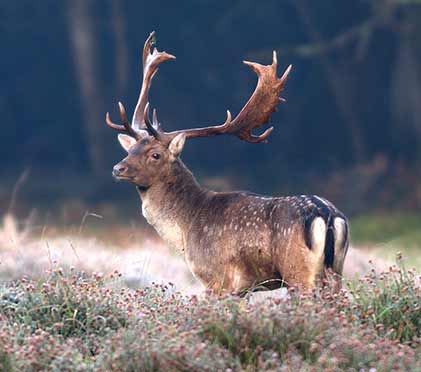New Forest deer: obtain closer views - an introduction

To obtain close views of fallow deer, red deer, roe deer and sika deer in the New Forest requires all the skills of a deer stalker, skills that date back to the earliest times, developed out of necessity when animals were first pursued for food and the hunters needed to combat their quarry’s keen senses of smell, hearing, and sight.
Nowadays, of course, few people of necessity hunt to eat, and stalking deer is no longer the sole preserve of those intent on killing.
In fact, stalking deer is equally important to wildlife photographers, people who wish to study these fascinating creatures and those who simply want a better view. And there are certainly few greater thrills to be had in the countryside than getting close to genuinely wild animals, whether by accident or after a lengthy, harmless pursuit.
The advice outlined here includes general principles for obtaining close views of deer, suggestions for clothing and equipment, and fieldcraft skills. It is unnecessary, though, to slavishly follow all the recommendations, particularly if brief, infrequent, long range views will satisfy. Attention to detail, however, will invariably be rewarded with more frequent, closer and more prolonged sightings.
But always remember, please, to avoid causing disturbance to the deer. This is particularly important in May and June when births take place, and during the rut, the deer’s breeding season and a critical time in their calendar. In particular, always leave the area as quietly as you arrived - after successfully stalking deer, it’s often tempting to relax and walk noisily away, which is likely to concern the deer just as much as a clumsy first approach.
New Forest deer - obtain closer views
New Forest deer - find out lots more
References:
The History of British Mammals: Derek Yalden
Roe Deer: John K. Fawcett, British Deer Society
New Forest Roe Deer: John K. Fawcett
Deer Watch: Richard Prior
Mammals of Britain and Europe: David McDonald, Priscilla Barret
Field Guide to British Deer: F J Taylor Page
More links
Other related links
Search this site

Sadly, 58 animals were killed - 35 ponies, 13 cows, 8 donkeys and 2 sheep, whilst a further 32 were injured - 3 pigs, 9 donkeys, 11 cows and 9 ponies.
(Forty-three accidents occurred in daylight, 15 at twilight and 101 in the dark. Twenty-seven accidents were not reported by the driver involved).
Here's just one horrific example - Three donkeys killed in collision with van at notorious New Forest blackspot (Advertiser and Times)

